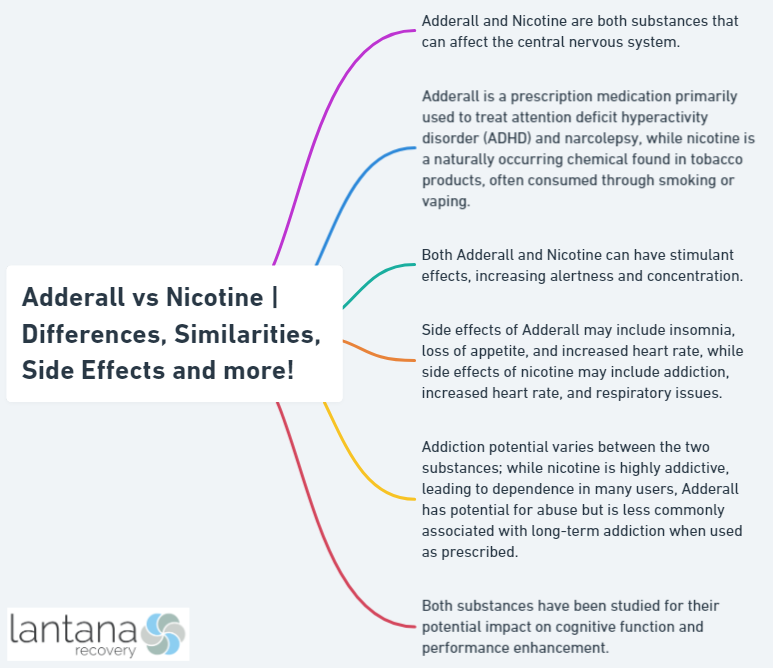Adderall and nicotine are two substances that have been used to enhance cognitive performance and are widely used in the United States. Adderall is a prescription stimulant commonly prescribed to treat attention deficit hyperactivity disorder (ADHD) and narcolepsy, while nicotine is found in tobacco products such as cigarettes and is one of the most widely used drugs in the country.
While the two substances have different chemical structures and effects on the body, both have been used to improve mental alertness, focus, and productivity. In this article, we will explore the similarities and differences between Adderall and nicotine, their effects on the body and mind, potential side effects, and more.
By understanding the key features of each substance, readers can make informed decisions about their use and weigh the potential risks and benefits.
What is Adderall?
Adderall is a prescription medication that is used to treat attention deficit hyperactivity disorder (ADHD) and narcolepsy. It is a brand name for a combination of two stimulant drugs: amphetamine and dextroamphetamine.
Adderall works by increasing the levels of certain chemicals in the brain, such as dopamine and norepinephrine, which can help to improve focus, attention, and impulse control. It’s important to note that Adderall is a controlled substance due to its potential for abuse and addiction.
It can cause side effects, such as anxiety, insomnia, loss of appetite, and increased heart rate and blood pressure. It should only be taken under the supervision of a healthcare professional and according to the prescribed dosage.
Chemical Composition of Adderall
Adderall is a combination of two active ingredients, amphetamine and dextroamphetamine, which are both central nervous system stimulants. These two drugs are combined in equal proportions to form the medication, and they work together to help improve focus, attention, and impulse control in people with ADHD.
What is Nicotine?
Nicotine is a naturally occurring chemical compound that is found in the leaves of the tobacco plant. It is a highly addictive substance and the primary psychoactive ingredient in tobacco products such as cigarettes, cigars, and chewing tobacco.
When nicotine is inhaled or consumed, it quickly enters the bloodstream and stimulates the release of various neurotransmitters, including dopamine, norepinephrine, and acetylcholine. This can lead to feelings of pleasure, increased alertness, and reduced anxiety.
Nicotine is often used recreationally or as a means to manage stress or anxiety, but it is a highly addictive substance that can be difficult to quit once someone has become addicted to it.

Chemical Composition of Nicotine
Nicotine is an alkaloid, which is a type of organic compound that contains nitrogen. It is composed of carbon, hydrogen, nitrogen, and sometimes oxygen. The chemical formula of nicotine is C10H14N2, and its molecular weight is 162.23 g/mol.
Adderall vs. Nicotine: Fact Sheet
|
Adderall |
Nicotine |
|
| Generic Name | Amphetamine/Dextroamphetamine | Nicorette |
| Drug Type | CNS Stimulant | Stimulant |
| Active Ingredients | Amphetamine | Nicotine |
| Used as treatment for: | ADHD and Narcolepsy | None |
| Available Form(s) | Both immediate and extended-release | Skin patches, chewing gum, nasal and oral sprays, inhalers, and cigarettes |
| Available Strengths |
|
For skin patches: 7 mg, 14 mg, 21 mg |
| Is it a controlled substance? | Schedule 2 controlled substance | No |
| Legal Status | Can only be prescribed medically | Legal |
| Risk of Withdrawal Effects | Yes | Yes |
| Risk of Addiction | Yes | Yes |
Nicotine Dosage and Side Effects:
The dosage of nicotine that is safe and appropriate depends on the method of administration, such as smoking, vaping, using nicotine gum, or using nicotine patches. The amount of nicotine that a person can safely tolerate varies depending on various factors such as age, weight, health status, and tolerance.
In general, smoking or vaping nicotine can deliver very high doses of nicotine, with a single cigarette containing around 1.1 to 1.8 mg of nicotine. However, nicotine gum, lozenges, and patches deliver a lower dose of nicotine, typically between 2 to 4 mg per dose.
The side effects of nicotine can range from mild to severe, depending on the amount of nicotine consumed and the person’s tolerance. Common side effects of nicotine include dizziness, nausea, headache, increased heart rate, and elevated blood pressure. Prolonged use of nicotine can lead to addiction, which can result in withdrawal symptoms such as irritability, anxiety, and insomnia.
Nicotine use has been linked to an increased risk of several health problems, including heart disease, stroke, lung cancer, and respiratory diseases. Pregnant women who use nicotine are also at increased risk of complications, including low birth weight and premature delivery.
It’s important to note that nicotine is a highly addictive substance, and quitting nicotine use can be challenging. People who are trying to quit nicotine should seek help from a healthcare professional and consider using nicotine replacement therapy, such as nicotine gum or patches, to help manage withdrawal symptoms.
Adderall Dosage and Side Effects

The dosage of Adderall prescribed by a healthcare professional depends on the individual’s medical condition, age, weight, and response to treatment. It is usually started at a low dose and gradually increased as necessary. Typically, the dosage for ADHD ranges from 5 to 60 mg per day, while the dosage for narcolepsy is higher, up to 60 mg per day.
Like all medications, Adderall can cause side effects. The most common side effects include decreased appetite, dry mouth, difficulty sleeping, headaches, nervousness, and stomach upset. Other potential side effects may include increased heart rate, high blood pressure, and mood changes.
Long-term use of Adderall may also lead to more serious side effects, such as dependence, addiction, and tolerance, where higher doses are needed to achieve the same effect. Misuse of Adderall can lead to potentially life-threatening side effects, including cardiovascular events, stroke, and sudden death.
It’s essential to take Adderall exactly as prescribed and to report any side effects to your healthcare provider. If you experience any unusual symptoms, such as chest pain, difficulty breathing, or changes in behavior, seek medical attention immediately.
It’s important to note that Adderall is a controlled substance due to its potential for abuse and addiction. It should only be used under the guidance of a healthcare professional and according to the prescribed dosage.
Nicotine vs. Adderall: Can You Withdrawal for Either?

Both nicotine and Adderall are known to be addictive substances that can cause withdrawal symptoms when use is stopped or reduced after prolonged use.
Nicotine withdrawal symptoms can start as soon as a few hours after the last use and can last for several weeks. Common symptoms of nicotine withdrawal include irritability, anxiety, restlessness, depressed mood, difficulty concentrating, and increased appetite.
Adderall withdrawal can also cause a range of physical and psychological symptoms, such as fatigue, insomnia, depression, anxiety, irritability, and changes in appetite. The duration and severity of the withdrawal symptoms may vary depending on the individual’s use of the drug, the dosage, and the length of use.
Withdrawal from both nicotine and Adderall can be challenging, and it’s important to seek medical help when attempting to quit these substances. Healthcare providers may recommend gradually reducing the dosage of the drug or using medications to manage withdrawal symptoms. Additionally, behavioral therapy and support groups can be helpful for people who are trying to quit nicotine or Adderall.
Adderall vs Nicotine: Prevalence in the United States

The use of Adderall and nicotine is prevalent in the United States, and both substances can have serious health consequences. According to the latest statistics by NSDUH, approximately 4.8% of adults in the United States reported using Adderall for non-medical purposes at some point in their lives. Among high school seniors, around 6% reported using Adderall without a prescription in the past year.
Similarly, nicotine use remains a significant public health concern, with approximately 14% of American adults reporting current cigarette smoking, and an estimated 32% of young adults aged 18-24 reporting current use of any tobacco products, including cigarettes, e-cigarettes, and other forms of tobacco.
These statistics highlight the need for increased public awareness of the risks associated with Adderall and nicotine use and the importance of seeking help for those struggling with addiction.
Bottom Line: Adderall versus Nicotine

Adderall and nicotine are two substances that can have significant impacts on a person’s health and well-being. Adderall is a medication commonly used to treat ADHD and narcolepsy, but it is also misused as a performance-enhancing drug or for recreational purposes.
Nicotine, on the other hand, is a highly addictive substance found in cigarettes, e-cigarettes, and other tobacco products. Both substances can cause a range of physical and psychological effects, and can be difficult to quit due to withdrawal symptoms.
Therefore, It’s important to seek help and support when dealing with addiction to either substance, and to take steps to prevent misuse or exposure.
FAQs on Nicotine and Adderall
Nicotine and Adderall: Which is more addictive?
It’s challenging to compare the addictiveness of nicotine and Adderall directly because they affect the brain in different ways and can have different degrees of impact on individual users. Both nicotine and Adderall are known to be highly addictive substances, and both can lead to dependence and withdrawal symptoms with prolonged use.
Is it safe to use Adderall for nicotine cessation?
The use of Adderall for nicotine cessation is not recommended unless it is prescribed and closely monitored by a healthcare professional. While it may be effective for some people in managing symptoms of nicotine withdrawal as per recent research, it is not specifically approved for this purpose and can have serious side effects.
Is it dangerous to mix nicotine with hallucinogens?
The combination of nicotine with hallucinogens is not recommended because it can have unpredictable and potentially dangerous effects. Hallucinogens such as psilocybin and LSD are a class of drugs that can cause significant alterations in perception, mood, and cognitive functioning, and the effects of these substances can be highly variable and unpredictable.





